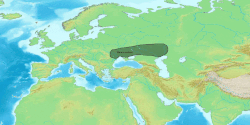This article should specify the language of its non-English content using {{ lang }} or {{ langx }}, {{ transliteration }} for transliterated languages, and {{ IPA }} for phonetic transcriptions, with an appropriate ISO 639 code. Wikipedia's multilingual support templates may also be used.(June 2021) |
| Proto-Indo-Iranian | |
|---|---|
| Proto-Indo-Iranic (PIIr) | |
| Reconstruction of | Indo-Iranian languages |
| Region | Eurasian Steppe |
| Era | Late 3rd m. BCE |
Reconstructed ancestor | |
| Lower-order reconstructions | |
| Part of a series on |
| Indo-European topics |
|---|
 |
Proto-Indo-Iranian, also called Proto-Indo-Iranic or Proto-Aryan, [1] is the reconstructed proto-language of the Indo-Iranian branch of Indo-European. Its speakers, the hypothetical Proto-Indo-Iranians, are assumed to have lived in the late 3rd millennium BC, and are often connected with the Sintashta culture of the Eurasian Steppe and the early Andronovo archaeological horizon.
Contents
- Descriptive phonology
- Two palatal series
- Laryngeal
- Accent
- Historical phonology
- Subsequent sound changes
- Morphology and basic vocabulary
- Personal pronouns (nominative case)
- Three examples of verbs
- Examples of noun declension
- An example of adjectival declension
- Numerals
- See also
- References
- Bibliography
- Further reading
- External links
Proto-Indo-Iranian was a satem language, likely removed less than a millennium from its ancestor, the late Proto-Indo-European language, and in turn removed less than a millennium from its descendants: Vedic Sanskrit (of the Rigveda) [2] and Old Avestan (of the Gathas).
It is the ancestor of Indo-Aryan languages, the Iranian languages, and the Nuristani languages, predominantly spoken in the Southern Asian subregion of Eurasia.